I came across a beautiful rangoli at Dataran Pahlawan ,Melaka.Sharing the snaps with all of you.With still the spirit of Deepavali in the air .........
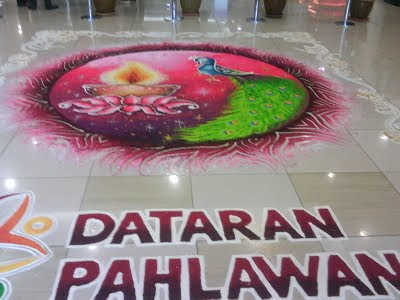

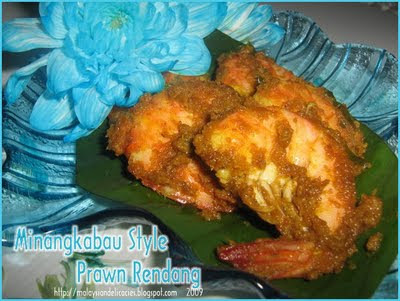
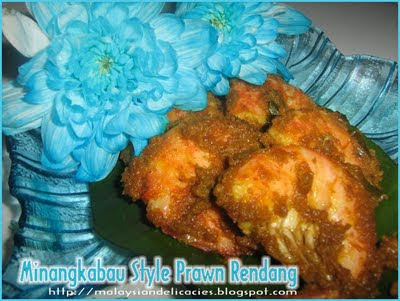
The above recipe is my contribution for the events
Diwali Dhamaka hosted by Purva
Think Spice-Think Coriander Seeds hosted by Priya of Priya's Easy N Tasty Recipes and started by Sunita Bhuvan
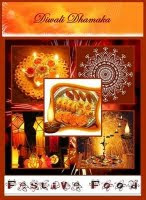

The mood of festivities is still on what with open house still going on not only for Deepavali but Hari Raya also. So a special dish for everyone to consider to serve during their open house.
Rendang is a dish which is considered to be a characteristic of Minangkabau culture, and is cooked 4-5 times a year.This prawn rendang recipe comes from Raya Fest, Azrah Kamalah Shashi’s new cookbook The book comes with 40 savoury and sweet recipes.She is a F&B professional and teach regular cooking classes and is author of many cookbooks . This variation of rendang with prawn won her a silver medal in the 1986 Culinaire competition for Malay food in Singapore.
The Minangkabau ethnic group (also known as Minang or Padang) is indigenous to the highlands of West Sumatra, in Indonesia. Their culture is matrilineal, with property and land passing down from mother to daughter, while religious and political affairs are the province of men (although some women also play important roles in these areas). Today 4 million Minangs live in West Sumatra, while about 3 million more are scattered throughout many Indonesian and Malay peninsula cities and towns. In Malaysia, they have a strong influence in Negeri Sembilan.
Negeri Sembilan ( English: "the State of nine") , is one of the 14 states that constitutes the Federation of Malaysia. It is located on the western coast of Peninsular Malaysia, just south of Kuala Lumpur and is bordered in the north by Selangor, in the east by Pahang and in the south by Malacca and Johor.
The name is believed to derive from the nine districts or negara (now known as luak) settled by the Minangkabau.Thus Minangkabau delicacies have a strong impact in the cuisine of Malaysia
The Minangkabau ethnic group (also known as Minang or Padang) is indigenous to the highlands of West Sumatra, in Indonesia. Their culture is matrilineal, with property and land passing down from mother to daughter, while religious and political affairs are the province of men (although some women also play important roles in these areas). Today 4 million Minangs live in West Sumatra, while about 3 million more are scattered throughout many Indonesian and Malay peninsula cities and towns. In Malaysia, they have a strong influence in Negeri Sembilan.
Negeri Sembilan ( English: "the State of nine") , is one of the 14 states that constitutes the Federation of Malaysia. It is located on the western coast of Peninsular Malaysia, just south of Kuala Lumpur and is bordered in the north by Selangor, in the east by Pahang and in the south by Malacca and Johor.
The name is believed to derive from the nine districts or negara (now known as luak) settled by the Minangkabau.Thus Minangkabau delicacies have a strong impact in the cuisine of Malaysia
Spice Paste
1 tbsp coriander seeds
½ tsp cumin seeds
½ tsp fennel seeds
10 bird eye’s chillies (I used 5 only)
8-10 shallots
4 cloves garlic
5cm ginger
5cm fresh turmeric
5cm galangal;
125ml oil for frying
10 large prawns
4 tsp chilli powder
1.5 litre coconut milk(extracted from 2 coconut)
2 stalks lemon grass,crushed
2 turmeric leaves,sliced thinly
50g toasted grated coconut (kerisik)
To make spice paste: Grind all the spices .Keep aside.
Heat oil in a wok over medium heat. Add prawns and fry until golden brown.Remove and set aside.
To make kerisik: In a wok, add in grated coconut.No oil added. Stir fry in low heat until coconut turn brown and oil start appearing.Close fire. Pound the coconut coarsely.Leave aside.
Use left over oil which the prawn was fried, sauté the spice paste with chilli powder.Stirring until aromatic. The secret to a good rendang is to thoroughly fry the spices.Once the spices are really dried, add in cocnut milk a little at a time,stirring continuously to mix well after each addition .Add lemongrass and turmeric leaves, cook until gravy thickens and oil start to float up slightly. Finalise by adding the prawns and kerisik.Stir to combine.Remove and serve.
1 tbsp coriander seeds
½ tsp cumin seeds
½ tsp fennel seeds
10 bird eye’s chillies (I used 5 only)
8-10 shallots
4 cloves garlic
5cm ginger
5cm fresh turmeric
5cm galangal;
125ml oil for frying
10 large prawns
4 tsp chilli powder
1.5 litre coconut milk(extracted from 2 coconut)
2 stalks lemon grass,crushed
2 turmeric leaves,sliced thinly
50g toasted grated coconut (kerisik)
To make spice paste: Grind all the spices .Keep aside.
Heat oil in a wok over medium heat. Add prawns and fry until golden brown.Remove and set aside.
To make kerisik: In a wok, add in grated coconut.No oil added. Stir fry in low heat until coconut turn brown and oil start appearing.Close fire. Pound the coconut coarsely.Leave aside.
Use left over oil which the prawn was fried, sauté the spice paste with chilli powder.Stirring until aromatic. The secret to a good rendang is to thoroughly fry the spices.Once the spices are really dried, add in cocnut milk a little at a time,stirring continuously to mix well after each addition .Add lemongrass and turmeric leaves, cook until gravy thickens and oil start to float up slightly. Finalise by adding the prawns and kerisik.Stir to combine.Remove and serve.
The above recipe is my contribution for the events
Diwali Dhamaka hosted by Purva
Think Spice-Think Coriander Seeds hosted by Priya of Priya's Easy N Tasty Recipes and started by Sunita Bhuvan


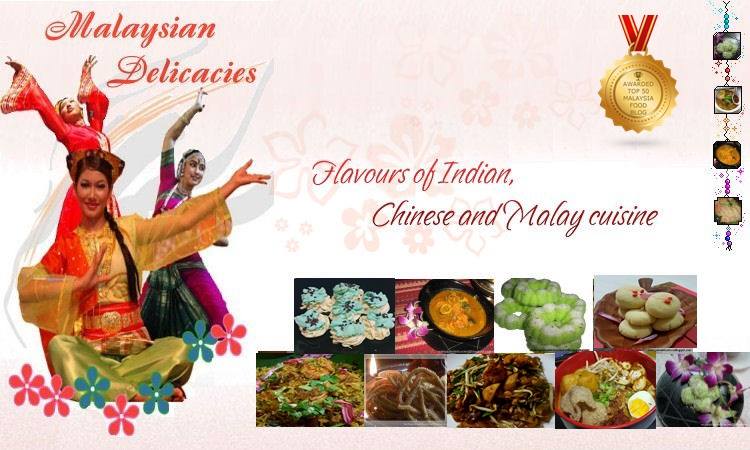
ooooooo.....love all those spice gravy all over the prawns. Rendang is just so delicious. Always eat beef rendang. Yet to try prawns rendang. It has to be good.
ReplyDeletevery nice!
ReplyDelete